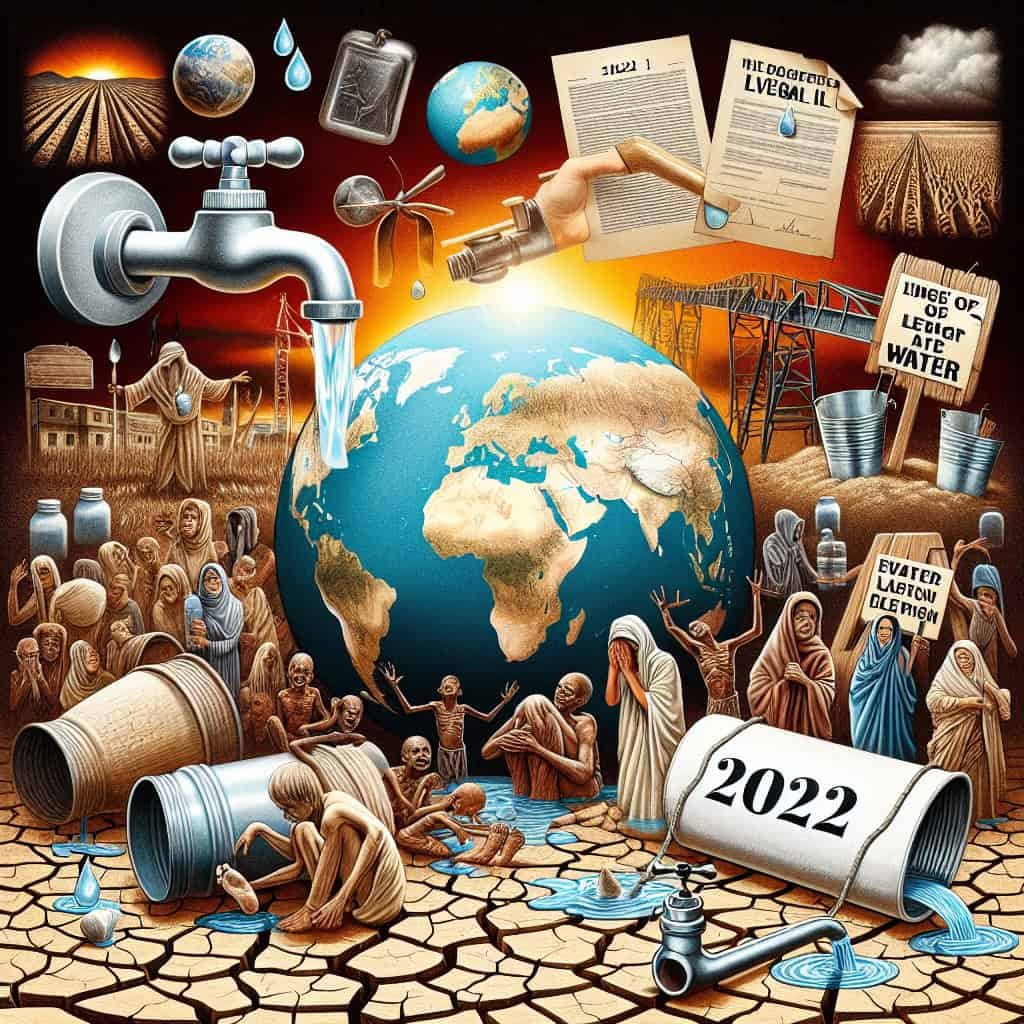In a potential situation that could wreak havoc on the economy, it is reported that around 15,000 water wells may be deemed illegal in 2022. This startling revelation has the potential to cause chaos not only in the water industry but also in various sectors that heavily rely on this crucial resource. As the legality of these wells is called into question, the impacts could ripple through agriculture, manufacturing, and even residential areas, affecting millions of people. The consequences of this issue are severe, and urgent action is needed to address the situation before it escalates into a full-blown crisis.

Challenges with Water Wells
Water wells are essential sources of clean and accessible water for communities around the world. However, they also face a range of challenges that can have significant consequences for both the environment and public health. In this article, we will explore the various challenges associated with water wells, including contamination, deterioration, and the drying up of wells. We will also discuss the impacts of these challenges on specific regions, as well as the potential solutions and mitigation strategies that can be implemented. Finally, we will examine the economic and governmental perspectives on water wells, highlighting the need for balanced approaches that address both economic needs and environmental protection.
Contamination of Drinking Water Wells
One of the most pressing challenges associated with water wells is the contamination of drinking water sources. This can occur due to a variety of factors, including industrial pollution, agricultural runoff, and improper waste disposal. Contaminants such as bacteria, heavy metals, and chemicals can seep into the groundwater and contaminate the water supply, posing significant health risks to those who rely on these wells for drinking water. It is crucial to address this challenge through proper monitoring, testing, and treatment of water wells.
Deterioration and Abandonment of Water Wells
Another challenge is the deterioration and abandonment of water wells. Over time, wells can deteriorate due to factors such as corrosion, soil erosion, and lack of maintenance. This can lead to decreased water quality and reduced well performance. In some cases, wells may be abandoned altogether, leaving communities without access to clean water. It is important to implement strategies to prevent the deterioration of water wells and to provide support for well owners to maintain their wells properly.
Impact of PFAS on Water Wells
PFAS (per- and polyfluoroalkyl substances) are a group of human-made chemicals that have been widely used in various industries for decades. These chemicals have been linked to a range of health issues, including cancer, reproductive problems, and immune system dysfunction. The presence of PFAS in water wells is a growing concern, as these chemicals can contaminate groundwater and pose significant risks to human health. Efforts should be made to treat PFAS contamination in water wells and to regulate the use and disposal of these chemicals to prevent further contamination.
Failure of Central Valley Water Wells
In the Central Valley of California, thousands of water wells are at risk of failure. This is primarily due to the overdrafting of groundwater resources, as agriculture in the region heavily relies on water from wells. The excessive pumping of groundwater has led to the subsidence of land and the depletion of aquifers, causing the wells to run dry. This poses a serious threat to the agricultural industry and the communities that depend on it. Solutions to this challenge may involve implementing sustainable groundwater management practices and investing in alternative water sources.
Drying up of Water Wells in Africa
In many regions of Africa, water scarcity is a significant challenge, with severe impacts on communities. Water wells in these areas are especially vulnerable to drying up due to climate change, population growth, and overuse of groundwater resources. This can result in a lack of clean water for drinking, cooking, and sanitation, leading to dire health consequences for the population. Addressing this challenge requires sustainable water management strategies, investment in resilient infrastructure, and community empowerment.
Issues with Private Water Wells
Private water wells, commonly found in rural areas, face unique challenges compared to public water supply systems. These wells are often not regulated or monitored, which can lead to contamination and health risks. Additionally, private well owners may lack the resources and knowledge to properly maintain their wells, leading to deterioration and reduced water quality. It is crucial to raise awareness among private well owners about the importance of regular testing and maintenance, as well as to provide resources and support to ensure their wells remain safe and functional.
Legalization of Water Wells
The legality of water wells is an issue that varies across different regions and jurisdictions. In some areas, water wells may be declared illegal due to concerns about overuse of groundwater resources or inadequate regulation. This can lead to economic chaos for communities that rely on these wells for their water supply, as well as disruptions to agricultural activities and local businesses. Balancing the need for regulation and oversight with the economic needs of communities is essential to ensure the sustainability of water resources and the well-being of affected populations.
Water Wells and Economic Chaos
The challenges associated with water wells can have far-reaching economic impacts. When water wells are declared illegal or face failure, communities relying on these wells may experience significant loss of income and livelihoods. The costs of finding alternative water sources or treating contaminated water can place a financial burden on individuals and businesses. Furthermore, the disruption of agricultural activities due to water scarcity can have ripple effects on local industries and economies. It is crucial for governments, policymakers, and stakeholders to consider the economic implications of water well challenges and to develop comprehensive strategies that address both environmental protection and economic sustainability.
Environmental Impact of Water Wells
Water wells can also have environmental consequences, particularly in terms of groundwater contamination and the impact on natural resources.
Water Wells and Groundwater Contamination
The contamination of groundwater sources as a result of water wells is a significant environmental concern. Improper well construction, inadequate maintenance, and the use of chemicals and fertilizers in nearby agricultural activities can all contribute to the contamination of groundwater. This can have detrimental effects on ecosystems and wildlife that depend on clean water sources. Moreover, once groundwater is contaminated, it can be challenging and costly to remediate. Efforts should be made to prevent contamination through proper well construction and management practices, as well as the regulation of nearby activities that may contribute to pollution.
Impact of Water Wells on Natural Resources
The extraction of water from wells can have a direct impact on natural resources, particularly in regions where water scarcity is a concern. Excessive pumping of groundwater can lead to the depletion of aquifers, which in turn can result in the drying up of streams, wetlands, and other natural water sources. This can have cascading effects on ecosystems and biodiversity. Sustainable water management practices, such as the implementation of groundwater recharge systems and the promotion of water conservation, are necessary to minimize the impact of water wells on natural resources.
Health Risks Associated with Water Wells
The challenges associated with water wells also pose significant health risks to individuals and communities relying on these water sources.
Health Hazards of Contaminated Drinking Water
Contamination of drinking water wells can result in various health hazards for consumers. Bacterial pathogens, such as E. coli, can cause gastrointestinal illnesses, while exposure to heavy metals and chemicals can lead to long-term health effects, including organ damage and cancer. Vulnerable populations, such as children and the elderly, are particularly at risk. It is essential to establish robust monitoring and testing programs to ensure the safety of drinking water from wells and to implement appropriate treatment methods when contamination is detected.
Risks of Arsenic Contamination in Water Wells
Arsenic contamination is a specific concern in some areas where naturally occurring arsenic in the groundwater can reach unsafe levels. Prolonged exposure to arsenic-contaminated water can lead to serious health issues, including skin lesions, cardiovascular diseases, and various types of cancer. Regular testing of wells in high-risk areas and the implementation of appropriate arsenic-removal technologies are crucial to mitigate these risks.
Regulation and Monitoring of Water Wells
To address the challenges associated with water wells effectively, comprehensive regulation and monitoring systems need to be established.
Need for Regulation of Water Wells
The regulation of water wells is essential to ensure their proper construction, maintenance, and operation. This includes establishing minimum standards for well construction, requiring regular testing for water quality, and implementing guidelines for the proper use and disposal of chemicals and wastewater. By regulating water wells, governments can protect public health, prevent contamination, and ensure the sustainable use of groundwater resources.
Monitoring and Testing of Water Wells
Regular monitoring and testing of water wells are essential to detect potential contamination and ensure the safety of drinking water supplies. Well owners should be encouraged to conduct routine testing for various contaminants, including bacteria, heavy metals, and chemicals. This can be achieved through education and outreach programs, as well as by providing resources and support to help well owners comply with testing requirements. Additionally, governments and regulatory agencies should establish robust systems for monitoring and data collection to assess the overall health and performance of water wells.
Governance and Oversight of Water Wells
Effective governance and oversight are crucial for ensuring the proper management and regulation of water wells. This includes the establishment of clear roles and responsibilities for government agencies, well owners, and other stakeholders involved in the management of water resources. Governments should also provide support and resources to well owners and communities to ensure they have the knowledge and tools to maintain and operate their wells properly. Furthermore, collaboration and coordination among government agencies, researchers, and community organizations are essential to address the complex challenges associated with water wells.

Water Wells in Specific Regions
Water wells face unique challenges and have specific impacts in different regions around the world. Let’s explore some examples.
Water Wells in Washington State
A recent military testing revealed that hundreds of drinking water wells in Washington State are contaminated with PFAS (per- and polyfluoroalkyl substances). PFAS are a group of chemicals that have significant health risks. It is crucial to address this issue by testing and treating contaminated wells, as well as implementing stricter regulations on the use and disposal of PFAS.
Water Wells in Bastrop County
Water wells in Bastrop County, Texas, have reached a nine-year low, highlighting the severe water scarcity in the region. This poses significant challenges for residents, agriculture, and local businesses. Investing in alternative water sources and implementing sustainable water management practices are necessary to mitigate the impact of water scarcity in Bastrop County.
Water Wells in Central Valley
In California’s Central Valley, thousands of water wells are at risk of failure due to overextraction of groundwater. This poses a severe threat to the agricultural industry and the communities that rely on it. To address this challenge, sustainable groundwater management practices should be implemented, including reducing water demand and investing in alternative water sources.
Water Wells in Texas
Texas is estimated to have 150,000 abandoned and deteriorating water wells, which can have significant economic and environmental consequences. The state’s government is considering legislation to regulate private water wells and provide support to well owners for maintenance and testing. This would help prevent further deterioration of wells and mitigate the risks associated with abandoned wells.
Water Wells in Africa
Water scarcity is a significant challenge in many regions of Africa, and water wells play a crucial role in providing clean and accessible water. However, climate change, population growth, and overuse of groundwater resources are leading to the drying up of wells. Investing in sustainable water management practices, such as rainwater harvesting and the use of solar-powered pumps, can help mitigate the impact of water scarcity in Africa.
Water Wells in California
In addition to the challenges faced by the Central Valley, water wells in other parts of California are also drying up due to the state’s ongoing drought. This has significant implications for agriculture, local communities, and the environment. Implementing water conservation measures, promoting alternative water sources, and investing in drought-resistant crops are essential to address the water scarcity crisis in California.
Solutions and Mitigation Strategies
To address the challenges associated with water wells, a range of solutions and mitigation strategies can be implemented.
Addressing Contamination in Drinking Water Wells
To address contamination in drinking water wells, it is crucial to implement regular testing and treatment programs. Well owners should be educated about the importance of water quality testing and provided with resources and support to ensure compliance. In cases of contamination, appropriate treatment technologies should be applied to remove or reduce contaminants to safe levels.
Preventing Deterioration and Abandonment of Water Wells
To prevent the deterioration and abandonment of water wells, well owners should be encouraged to adopt proper maintenance practices. This can be achieved through education and outreach programs, providing resources and incentives for well inspection and maintenance, and establishing well construction standards to ensure durability. Implementing well abandonment programs can also help address the issue of abandoned wells.
Treating PFAS Contamination in Water Wells
Treating PFAS contamination in water wells requires specialized treatment technologies. This can include activated carbon filtration, ion exchange, or advanced oxidation processes. Implementing remediation programs and regulating the use and disposal of PFAS can help prevent further contamination.
Improving Central Valley Water Wells
Improving water wells in California’s Central Valley involves implementing sustainable groundwater management practices. This includes promoting water conservation, investing in alternative water sources, and reducing water demand through improved irrigation techniques. Additionally, communities should explore options for water storage and recharge systems to replenish depleted aquifers.
Investing in Sustainable Water Wells in Africa
In Africa, investing in sustainable water wells is essential to address the water scarcity crisis. This can involve the construction of durable, properly maintained wells, the use of solar-powered pumps for sustainable water extraction, and the implementation of rainwater harvesting systems. Community involvement and capacity building are crucial for the long-term success of these initiatives.
Strengthening Regulation and Monitoring of Water Wells
To address the challenges associated with water wells, it is necessary to strengthen regulations and monitoring systems. This includes establishing clear guidelines for well construction and maintenance, implementing regular testing and monitoring programs, and ensuring compliance through robust enforcement mechanisms. Collaboration between government agencies, researchers, and community organizations is vital for effective monitoring and governance of water wells.

Economic Impact of Declared Illegal Water Wells
The declaration of water wells as illegal can have significant economic consequences for affected communities.
Loss of Income and Livelihoods
When water wells are declared illegal, communities that rely on these wells may experience a loss of income and livelihoods. This is particularly true for agricultural communities that rely on water wells for irrigation. Without access to reliable and legal water sources, farmers may face crop failures and reduced productivity, leading to financial hardship and unemployment.
Increased Costs and Expenses
The declaration of water wells as illegal can result in increased costs and expenses for individuals and businesses. Well owners may be required to find alternative water sources or invest in costly treatment systems to comply with regulations. Additionally, the cost of legalizing water wells, including obtaining permits and conducting required testing, can be a financial burden for well owners.
Disruption of Agricultural Activities
The declaration of water wells as illegal can disrupt agricultural activities, leading to reduced crop yields and food production. This can have broader economic implications, including increased food prices, food insecurity, and reduced export opportunities. It is crucial to develop strategies to address water scarcity and ensure the sustainability of agricultural activities in affected regions.
Impact on Local Businesses and Industries
The declaration of water wells as illegal can also have a significant impact on local businesses and industries. For example, industries reliant on water for manufacturing processes may face production disruptions and increased costs due to the need to find alternative water sources. Service industries that depend on the agricultural sector, such as transportation and logistics, may also suffer from reduced demand and economic downturn.
Government Response and Policy
Governments play a critical role in addressing water well challenges and implementing effective policies.
Government Initiatives to Address Water Wells
Governments can take various initiatives to address water well challenges. This can include the establishment of regulatory frameworks for well construction and maintenance, the implementation of monitoring and testing programs, and the provision of resources and financial support to well owners. Governments should also collaborate with research institutions, non-profit organizations, and community stakeholders to develop comprehensive strategies and solutions.
Proposed Policies and Regulations
Proposed policies and regulations can help address the challenges associated with water wells. This may include stricter regulations on well construction and maintenance, mandatory testing and reporting of water quality, and the development of resource allocation plans to ensure the sustainable use of groundwater resources. Public participation and stakeholder engagement are crucial in the development and implementation of these policies.
Response to Economic Chaos Caused by Declared Illegal Water Wells
To address the economic chaos caused by the declaration of water wells as illegal, governments should provide support to affected communities. This can involve financial assistance, subsidies, and incentives for well owners to comply with regulations. Governments should also explore alternative water sources and invest in infrastructure projects that can provide reliable and legal water supplies to affected communities. Balancing economic needs with environmental protection is essential to ensure the well-being of both individuals and the environment.

Community and Stakeholder Perspectives
Understanding the perspectives of local communities and stakeholders is crucial for effectively addressing water well challenges.
Impact on Local Communities and Residents
The impact of water well challenges on local communities and residents can be significant. Communities that rely on water wells for their water supply may face health risks, economic hardships, and disruptions to their daily lives. It is important to include the perspectives and voices of affected communities in decision-making processes to ensure their needs and concerns are addressed.
Concerns and Fears of Water Well Owners
Water well owners may have concerns and fears regarding the challenges associated with their wells. These can include worries about water quality, the cost of maintaining and testing wells, and the potential consequences of well failure or declaration of illegality. Providing education, resources, and support to well owners can help address their concerns and empower them to take an active role in maintaining and protecting their wells.
Role of Stakeholders in Addressing Water Wells Issue
Multiple stakeholders, including government agencies, non-profit organizations, researchers, and well owners, play a crucial role in addressing water well issues. Collaboration and cooperation among these stakeholders are essential for developing effective strategies and solutions. Stakeholders should be engaged in decision-making processes and provided with opportunities for input and participation.
Conclusion
The challenges associated with water wells, including contamination, deterioration, and the drying up of wells, pose significant risks to public health, the environment, and the economy. Addressing these challenges requires comprehensive strategies that balance the need for water access with environmental protection. Governments, policymakers, and stakeholders must work together to strengthen regulation and monitoring systems, invest in sustainable solutions, and empower communities to protect and maintain their water wells. By taking a proactive and collaborative approach, we can ensure the availability of clean and accessible water for present and future generations while protecting the environment.


